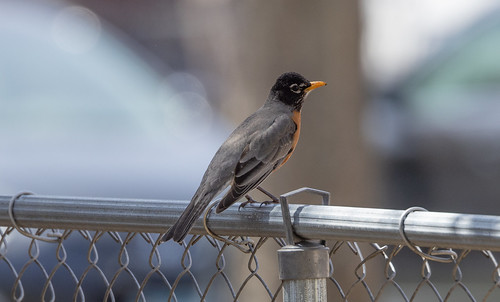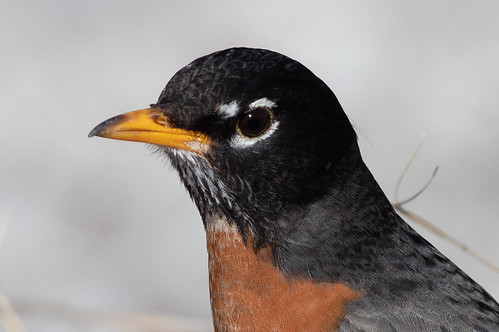 |
| My front-yard robin. This is the best photo I have of him so far. |
On Mother’s Day, I awoke a little after 4 AM hearing a robin singing somewhere out front. I like to wake up that early, set my sound recorder in my backyard to capture morning song, and head back to bed or get to work. In the past few weeks I’ve mostly headed back to bed while I recover from Covid.
My weather app said rain was imminent. There’s nowhere in the backyard where my equipment is safe from rain, but that persistent robin out front inspired me to try something new. Our front porch is covered, so I set my recorder there, pointed its shotgun microphone in an area between a spruce tree and a small maple—the robin sings from both—and started recording at 4:14 AM. That’s how I made the best robin song recording I’ve ever managed, with a perfect 11-minute stretch when the bird must have been perched precisely in line with the microphone. But it bothered me all day that I had no idea what time he had started.
Back when I took my first ornithology class the summer of 1975, just a few months after I started birding, I had to pull an all-nighter to finish my field research paper. Our apartment was too small for me to play music to help me stay awake after Russ went to bed, but a robin spent the whole night singing not far from my open window. Hour after hour after hour, he kept me company, and I finished the paper just before I had to leave for class. Whew! I still wonder if I’d have finished that paper on time had that robin not been pulling an all-nighter of his own.
My Peabody Street robin wasn’t singing when I went to bed Saturday night, but what time did he start? Was he singing loud from his first note or did he begin softly and build up gradually? Did he make any preliminary notes before his actual song?
Suddenly, I realized how very easy it would be to answer these questions and more—indeed, I was embarrassed not to have done this much sooner. My Zoom H6 sound recorder was right there in my hands, as obvious as Dorothy's ruby slippers. All I had to do was start recording before I went to bed. My sound files are time-stamped, so the recording would tell me exactly when the robin started singing.
On Sunday night, the Peabody Street robin definitely did not pull an all-nighter. The waveform didn’t show any nearby sounds except the footsteps of people walking by and a few cars until 3:42 AM, when the robin made a chatter call from a short distance away (he probably sleeps in the spruce tree), then came closer and made two chatter calls in quick succession, and immediately started singing away. This was just about exactly 2 hours before sunrise. Here's the link to the entire, unedited hour-and-a-half song bout beginning when the robin did.
He kept going strong until about 5:17, probably stopping for breakfast with his mate when it was just starting to get light, about 20 minutes before sunrise. Meanwhile, a chickadee made a few dee dee dee calls at 4:32, an hour and ten minutes or so before sunrise, and that one or another started singing persistently at 5:05, over a half hour before sunrise.
While my ears were still working properly, I used to do a Breeding Bird Survey in northern Minnesota every June. I was supposed to start my survey at 4:38 AM exactly, a half hour before local sunrise. I usually got there at least 10 minutes early—sometimes closer to a half hour—but never once did I get there before a lot of birds were already in full song.
 |
| Here's Don Kroodsma in the Sierra Nevadas during our Cornell Lab Field Recording Workshop. |
Back in 2001, when I took the Cornell Lab of Ornithology’s field recording course in the Sierra Nevadas, Don Kroodsma was a guest lecturer who was planning to come along the day of our field trip to record the “dawn chorus.” I expected us to be leaving at 2 or so, and certainly no later than 3, which was clearly what Don Kroodsma expected, too, but groans from the rest of the group led to what I thought was a horrible compromise—we wouldn’t even be leaving until 5 AM. Don decided the heck with us and headed to the site at the proper time. We arrived in time to hear a lot of morning bird song, but it was far from the magical experience of a true dawn chorus. Don and I laughed about this the last time we talked, a year ago. He remembered he had just finished recording for the day when our group finally showed up. He also remembered that I wanted to start out as early as he did.
Another man named Don was tailing Don Kroodsma that spring while researching a book about bird song. Within the chapter about this Cornell workshop, he quoted a couple of the male participants by name, but the only time he quoted a woman, he mentioned her affiliation without naming her. He also described the discussion of when we should leave for the dawn chorus field trip, but claimed that Don Kroodsma was the only person who wanted to leave early—according to his book, all the class participants wanted to sleep in. Women back then tended to graciously overlook the many times a man ignored us or blew us off. I’m so glad my children’s generation has a stronger sense of fairness. But the big takeaway is that what we call a dawn chorus begins way, way before sunrise. The early birder really does catch the worm-eating birds.
